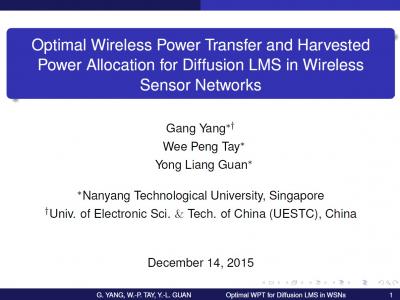Documents
Presentation Slides
Optimal Wireless Power Transfer and Harvested Power Allocation for Diffusion LMS in Wireless Sensor Networks

- Citation Author(s):
- Submitted by:
- Gang Yang
- Last updated:
- 23 February 2016 - 1:44pm
- Document Type:
- Presentation Slides
- Document Year:
- 2015
- Event:
- Presenters:
- Weidong MEI
- Categories:
- Log in to post comments
This paper investigates the use of wireless power transfer (WPT) for {measurement sensing} and information transmission in a wireless sensor network (WSN) performing distributed parameter estimation using an adaptive diffusion least mean-squares (LMS) strategy. We consider a hybrid WSN consisting of common sensor nodes (CNs) and super sensor nodes (SNs) that are capable of WPT. In each diffusion iteration, all nodes sense measurements and exchange parameter estimates with their neighbors. Each SN also transfers wireless power to its neighboring CNs via beamforming. To minimize the steady-state network mean-square-deviation (MSD), we jointly optimize the {beamforming parameters} for SNs to perform WPT, and the fraction of the harvested power allocated by each CN to {measurement sensing and information transmission}. We show that the problem is primal decomposable, and propose a distributed subgradient-based algorithm to find the optimal solutions in an iterative manner. Simulation results suggest that compared to the conventional case where there is no WPT, the network MSD is reduced by up to approximately $10$ dB, because of lower sensing noise and higher information transmission power due to the additional harvested power at the CNs.

